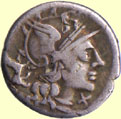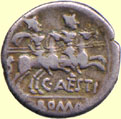Return to Table of Contents - next Message
Dear Sir:
I have spent the last two hours looking at your website to see if I could
match my coin with one of yours. I was told by a coin shop it was a
silver Roman denarius. On your site, it comes very close to the coins
on your first list (new browser window with this link), third from left, dated 205-62 B.C. It is in very
good shape, but differs slightly from the one you have pictured. Could
it be one you do not have? Or do some differ slightly from the same
era? How can I verify my coin? Your help would be very much
appreciated.
Please feel free to write back at the above address. Perhaps you know
of some one else who might be interestd or could help me in some way.
Yours respectfully,
Deborah
***************************************
Dear Deborah:
It appears that you have a Roman silver denarius from the Republican
period. As you surmised, there are many different variants on this basic
type. On many, you will find an X or an X with a vertical stroke theough
it
(looking somewhat like an asterisk). This indicates a denarius of ten
copper asses. Later, the denarius was valued at sixteen copper asses, and,
as the soldiers of the day were paid in copper, this devaluation of the
copper caused much discontent.
 Most have an image of Roma wearing a crested or winged helmet. Popular
reverses included the Heavanly Twins Castor and Pollux, legendary
protectors
of Rome or some variant of Victory driving a chariot. The chariot could be
a two horse (biga) or a four horse (quadriga) chariot. Castor and Pollux
are usually on horseback and hold spears, but victory may hold any one of
several attributes (the term here is used to describe symbolic objects
shown in association with deities or allegorical figures). Victory's most common attributes are a wreath or a branch of some kind.
Most have an image of Roma wearing a crested or winged helmet. Popular
reverses included the Heavanly Twins Castor and Pollux, legendary
protectors
of Rome or some variant of Victory driving a chariot. The chariot could be
a two horse (biga) or a four horse (quadriga) chariot. Castor and Pollux
are usually on horseback and hold spears, but victory may hold any one of
several attributes (the term here is used to describe symbolic objects
shown in association with deities or allegorical figures). Victory's most common attributes are a wreath or a branch of some kind.  I have reproduced images of the obverse and reverse of the coin you have mentioned for the benefit of the readers of my Imperial Post pages.
I have reproduced images of the obverse and reverse of the coin you have mentioned for the benefit of the readers of my Imperial Post pages.
In summary, it sounds like you have a nice historical piece that was new at
the time of the Second punic War when Hannibal was mucking about the
Italian countryside causing so much of a ruckus for the Romans.
Return to Table of Contents - next Message
 Most have an image of Roma wearing a crested or winged helmet. Popular
reverses included the Heavanly Twins Castor and Pollux, legendary
protectors
of Rome or some variant of Victory driving a chariot. The chariot could be
a two horse (biga) or a four horse (quadriga) chariot. Castor and Pollux
are usually on horseback and hold spears, but victory may hold any one of
several attributes (the term here is used to describe symbolic objects
shown in association with deities or allegorical figures). Victory's most common attributes are a wreath or a branch of some kind.
Most have an image of Roma wearing a crested or winged helmet. Popular
reverses included the Heavanly Twins Castor and Pollux, legendary
protectors
of Rome or some variant of Victory driving a chariot. The chariot could be
a two horse (biga) or a four horse (quadriga) chariot. Castor and Pollux
are usually on horseback and hold spears, but victory may hold any one of
several attributes (the term here is used to describe symbolic objects
shown in association with deities or allegorical figures). Victory's most common attributes are a wreath or a branch of some kind.  I have reproduced images of the obverse and reverse of the coin you have mentioned for the benefit of the readers of my Imperial Post pages.
I have reproduced images of the obverse and reverse of the coin you have mentioned for the benefit of the readers of my Imperial Post pages.